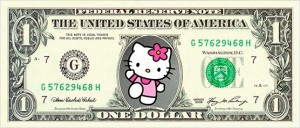We are near the edge of the Fiscal Cliff. Both Congress and the White House are deadlocked in their attempts to find solutions to cutting government spending and/or increasing revenue through tax changes. What are we to do?
A simple change in our “money policies” could increase significantly US Treasury revenues and significantly reduce our deficit. Here’s how. We could issue Hello Kitty Kash!
The US Treasury could decide next week that it is perfectly legal, financially advantageous, and nearly required to achieve fiduciary and ethical responsibilities, to enable all people and companies that wish to have their own personal or corporate images appear on the face of our one-dollar bills and their organizational or corporate logos to appear on the back. I mention this denomination in particular, because recently proposals have been made to eliminate this bill, and to issue one-dollaray coins instead, thereby saving abut four to five billon dollars (over 30 years!). But this action completely overlooks the public relations and design value of this familiar and much loved cultural artifact, our most “populist” denomination.Persons or groups wishing to buy “FaceSpace” on one-dollar bills, would have to pay $100 million per image, or $200 million per set of sides.There are about three billion one-dollar bills in circulation, the most of any denomination. These bills last about 21 months, which means that every two years, the Treasury could issue new editions. If there were only 500 sponsors of these images/logos (there are 400 billionaires in the USA alone), the US Government could quickly raise $50 billion over a two-year cycle. In ten cycles, this translates to $500 billion, or one-half of the current national deficit.Using a design-thinking approach to innovation, the one-dollar bill is a valuable medium of communication, one that has significant cultural and media value. Think about it. Sanrio might sponsor Hello Kitty Kash. Hello Kitty now exceeds Mickey Mouse in the number of image results on a Google search. Disney might sponsor Mickey. There many companies and organizations that would line up to see their favorite person, persona, or symbol conveyed worldwide in a way that has become acceptable in other media. Even hotel plastic door-key cards contain ads for Macy’s, for example. People, characters, and companies/organizations within and outside the US might contribute to the cost of these FaceBucks, thereby enabling wealthy individuals or groups to contribute to the reduction of the US deficit.
Our US currency has been undergoing significant graphic redesign. Now is the perfect time to make this historic change in “outside funding” of our currency. The cost of printing and detecting such bills would not be prohibitively expensive. These FaceBucks might become highly desirable outside the US as well, much like our movie production, which might bring further sponsor contributions and collectibles desirability. Perhaps the US Post Offices could handle distribution, just as they do with commorative stamps, thereby adding economic value to these established buldings and people, which are now threatened by being de-commisioned as economically non-viable.
While people complain about money spent to buy elections, wasted on porkbarrel projects, or debatable entitlements, let’s make a radical shift in thinking. FaceBucks enables people to buy FaceSpace. Taxing the wealthiest corporations and individuals is always challenging.This simple suggestion gives sponsors with wealth a tangible benefit in return for their funds: something desirable, valuable, and noteworthy. FaceBucks also recognizes that our currency is one of our valuable remaining iconic worldwide communication “products.” FaceBucks would allow the US government to use money to make money. The Fiscal Cliff is almost here. We can’t ignore this opportunity.
______________________________
Figure Caption: Hello Kitty dollar, or Hello Kitty Kash.
Author:
Mr. Aaron Marcus, Aaron Marcus and Associates, Inc.
Berkeley, California
Version: 16 December 2012.
May be reprinted in whole or edited form, with citation. Hello Kitty image is copyright and trademarked by Sanrio, Inc., and appears under fair-use practice for educational and artistic/design usage.
